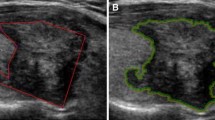Abstract
To determine which Breast Imaging Reporting and Data System (BI-RADS) descriptors for ultrasound are predictors for breast cancer using logistic regression (LR) analysis in conjunction with interobserver variability between breast radiologists, and to compare the performance of artificial neural network (ANN) and LR models in differentiation of benign and malignant breast masses. Five breast radiologists retrospectively reviewed 140 breast masses and described each lesion using BI-RADS lexicon and categorized final assessments. Interobserver agreements between the observers were measured by kappa statistics. The radiologists’ responses for BI-RADS were pooled. The data were divided randomly into train (n = 70) and test sets (n = 70). Using train set, optimal independent variables were determined by using LR analysis with forward stepwise selection. The LR and ANN models were constructed with the optimal independent variables and the biopsy results as dependent variable. Performances of the models and radiologists were evaluated on the test set using receiver-operating characteristic (ROC) analysis. Among BI-RADS descriptors, margin and boundary were determined as the predictors according to stepwise LR showing moderate interobserver agreement. Area under the ROC curves (AUC) for both of LR and ANN were 0.87 (95% CI, 0.77–0.94). AUCs for the five radiologists ranged 0.79–0.91. There was no significant difference in AUC values among the LR, ANN, and radiologists (p > 0.05). Margin and boundary were found as statistically significant predictors with good interobserver agreement. Use of the LR and ANN showed similar performance to that of the radiologists for differentiation of benign and malignant breast masses.

Similar content being viewed by others
References
Jackson VP, Reynolds HE, Hawes DR: Sonography of the breast. Semin Ultrasound CT MR 17:460–475, 1996
Radiology ACo: ACR Standards 2000–2001. American College of Radiolo, Reston, 2000
Baker JA, Soo MS: Breast US, assessment of technical quality and image interpretation. Radiology 223:229–238, 2002
Baker JA, Soo MS, Rosen EL: Artifacts and pitfalls in sonographic imaging of the breast. AJR 176:1261–1266, 2001
Rizzatto GJ: Towards a more sophisticated use of breast ultrasound. Eur Radiol 11:2425–2435, 2001
Schroeder RJ, Bostanjoglo M, Rademaker J, Maeurer J, Felix R: Role of power Doppler techniques and ultrasound contrast enhancement in the differential diagnosis of focal breast lesions. Eur Radiol 13:68–79, 2003
Dempsey PJ: The history of breast ultrasound. J Ultrasound Med 23:887–894, 2004
Stavros AT, Thickman D, Rapp CL, Dennis MA, Parker SH, Sisney GA: Solid breast nodules: use of sonography to distinguish between benign and malignant lesions. Radiology 196:123–134, 1995
Berg WA, Gutierrez L, NessAiver MS, Carter WB, Bhargavan M, Lewis RS, et al: Diagnostic accuracy of mammography, clinical examination, US, and MR imaging in preoperative assessment of breast cancer. Radiology 233:830–849, 2004
Mendelson EB: Problem-solving ultrasound. Radiol Clin North Am 42:909–918, 2004
Mehta TS: Current uses of ultrasound in the evaluation of the breast. Radiol Clin North Am 41:841–856, 2003
Radiology ACo: Breast Imaging Reporting and Data System, Ultrasound, 4th edition. American College of Radiology, Reston, 2003
Baker JA, Kornguth PJ, Floyd Jr, CE: Breast imaging reporting and data system standardized mammography lexicon: observer variability in lesion description. AJR 166:773–778, 1996
Lazarus E, Mainiero MB, Schepps B, Koelliker SL, Livingston LS: BI-RADS lexicon for US and mammography: interobserver variability and positive predictive value. Radiology 239:385–391, 2006
Lee HJ, Kim EK, Kim MJ, Youk JH, Lee JY, Kang DR, et al: Observer variability of Breast Imaging Reporting and Data System (BI-RADS) for breast ultrasound. Eur J Radiol 65:293–298, 2008
Abdullah N, Mesurolle B, El-Khoury M, Kao E: Breast imaging reporting and data system lexicon for US: interobserver agreement for assessment of breast masses. Radiology 252:665–672, 2009
Park CS, Lee JH, Yim HW, Kang BJ, Kim HS, Jung JI, et al: Observer agreement using the ACR Breast Imaging Reporting and Data System (BI-RADS)-ultrasound, First Edition (2003). Korean J Radiol 8:397–402, 2007
Song JH, Venkatesh SS, Conant EA, Arger PH, Sehgal CM: Comparative analysis of logistic regression and artificial neural network for computer-aided diagnosis of breast masses. Acad Radiol 12:487–495, 2005
Ayer T, Chhatwal J, Alagoz O, Kahn Jr, CE, Woods RW, Burnside ES: Comparison of logistic regression and artificial neural network models in breast cancer risk estimation. Radiographics 30:13–22, 2010
Tu JV: Advantages and disadvantages of using artificial neural networks versus logistic regression for predicting medical outcomes. J Clin Epidemiol 49:1225–1231, 1996
Hecht-Nielsen R: Replicator neural networks for universal optimal source coding. Science 269:1860–1863, 1995
Baker JA, Kornguth PJ, Lo JY, Floyd Jr, CE: Artificial neural network: improving the quality of breast biopsy recommendations. Radiology 198:131–135, 1996
Baker JA, Kornguth PJ, Lo JY, Williford ME, Floyd Jr, CE: Breast cancer: prediction with artificial neural network based on BI-RADS standardized lexicon. Radiology 196:817–822, 1995
Wu Y, Giger ML, Doi K, Vyborny CJ, Schmidt RA, Metz CE: Artificial neural networks in mammography: application to decision making in the diagnosis of breast cancer. Radiology 187:81–87, 1993
Landis JR, Koch GG: The measurement of observer agreement for categorical data. Biometrics 33:159–174, 1977
Chou YH, Tiu CM, Hung GS, Wu SC, Chang TY, Chiang HK: Stepwise logistic regression analysis of tumor contour features for breast ultrasound diagnosis. Ultrasound Med Biol 27:1493–1498, 2001
Hanley JA, McNeil BJ: A method comparing the areas under receiver operator characteristic curves derived from the same cases. Radiology 148:839–843, 1983
Hong AS, Rosen EL, Soo MS, Baker JA: BI-RADS for sonography: positive and negative predictive values of sonographic features. AJR 184:1260–1265, 2005
Author information
Authors and Affiliations
Corresponding author
Rights and permissions
About this article
Cite this article
Kim, S.M., Han, H., Park, J.M. et al. A Comparison of Logistic Regression Analysis and an Artificial Neural Network Using the BI-RADS Lexicon for Ultrasonography in Conjunction with Introbserver Variability. J Digit Imaging 25, 599–606 (2012). https://doi.org/10.1007/s10278-012-9457-7
Published:
Issue Date:
DOI: https://doi.org/10.1007/s10278-012-9457-7




